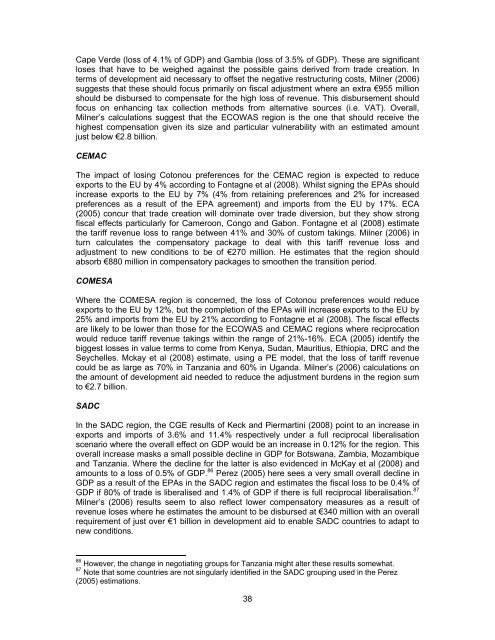EPA Review Annex Documents - DFID
EPA Review Annex Documents - DFID
EPA Review Annex Documents - DFID
You also want an ePaper? Increase the reach of your titles
YUMPU automatically turns print PDFs into web optimized ePapers that Google loves.
Cape Verde (loss of 4.1% of GDP) and Gambia (loss of 3.5% of GDP). These are significant<br />
loses that have to be weighed against the possible gains derived from trade creation. In<br />
terms of development aid necessary to offset the negative restructuring costs, Milner (2006)<br />
suggests that these should focus primarily on fiscal adjustment where an extra €955 million<br />
should be disbursed to compensate for the high loss of revenue. This disbursement should<br />
focus on enhancing tax collection methods from alternative sources (i.e. VAT). Overall,<br />
Milner’s calculations suggest that the ECOWAS region is the one that should receive the<br />
highest compensation given its size and particular vulnerability with an estimated amount<br />
just below €2.8 billion.<br />
CEMAC<br />
The impact of losing Cotonou preferences for the CEMAC region is expected to reduce<br />
exports to the EU by 4% according to Fontagne et al (2008). Whilst signing the <strong>EPA</strong>s should<br />
increase exports to the EU by 7% (4% from retaining preferences and 2% for increased<br />
preferences as a result of the <strong>EPA</strong> agreement) and imports from the EU by 17%. ECA<br />
(2005) concur that trade creation will dominate over trade diversion, but they show strong<br />
fiscal effects particularly for Cameroon, Congo and Gabon. Fontagne et al (2008) estimate<br />
the tariff revenue loss to range between 41% and 30% of custom takings. Milner (2006) in<br />
turn calculates the compensatory package to deal with this tariff revenue loss and<br />
adjustment to new conditions to be of €270 million. He estimates that the region should<br />
absorb €880 million in compensatory packages to smoothen the transition period.<br />
COMESA<br />
Where the COMESA region is concerned, the loss of Cotonou preferences would reduce<br />
exports to the EU by 12%, but the completion of the <strong>EPA</strong>s will increase exports to the EU by<br />
25% and imports from the EU by 21% according to Fontagne et al (2008). The fiscal effects<br />
are likely to be lower than those for the ECOWAS and CEMAC regions where reciprocation<br />
would reduce tariff revenue takings within the range of 21%-16%. ECA (2005) identify the<br />
biggest losses in value terms to come from Kenya, Sudan, Mauritius, Ethiopia, DRC and the<br />
Seychelles. Mckay et al (2008) estimate, using a PE model, that the loss of tariff revenue<br />
could be as large as 70% in Tanzania and 60% in Uganda. Milner’s (2006) calculations on<br />
the amount of development aid needed to reduce the adjustment burdens in the region sum<br />
to €2.7 billion.<br />
SADC<br />
In the SADC region, the CGE results of Keck and Piermartini (2008) point to an increase in<br />
exports and imports of 3.6% and 11.4% respectively under a full reciprocal liberalisation<br />
scenario where the overall effect on GDP would be an increase in 0.12% for the region. This<br />
overall increase masks a small possible decline in GDP for Botswana, Zambia, Mozambique<br />
and Tanzania. Where the decline for the latter is also evidenced in McKay et al (2008) and<br />
amounts to a loss of 0.5% of GDP. 86 Perez (2005) here sees a very small overall decline in<br />
GDP as a result of the <strong>EPA</strong>s in the SADC region and estimates the fiscal loss to be 0.4% of<br />
GDP if 80% of trade is liberalised and 1.4% of GDP if there is full reciprocal liberalisation. 87<br />
Milner’s (2006) results seem to also reflect lower compensatory measures as a result of<br />
revenue loses where he estimates the amount to be disbursed at €340 million with an overall<br />
requirement of just over €1 billion in development aid to enable SADC countries to adapt to<br />
new conditions.<br />
86<br />
However, the change in negotiating groups for Tanzania might alter these results somewhat.<br />
87<br />
Note that some countries are not singularly identified in the SADC grouping used in the Perez<br />
(2005) estimations.<br />
38
















